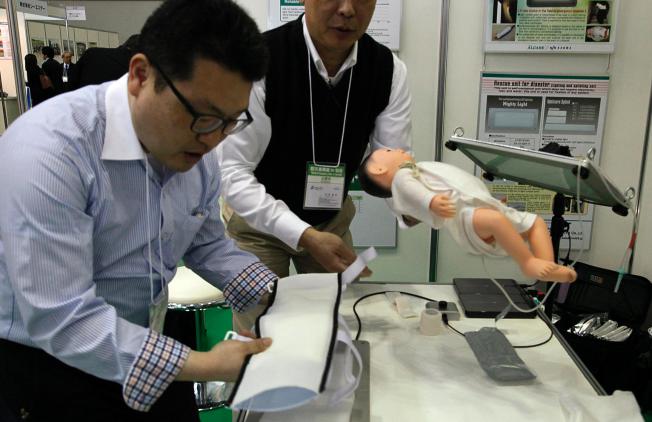Mankind is powerless to prevent calamities such as typhoons and earthquakes, but in Japan where the devastating 2011 tsunami still looms large, there’s a flourishing industry in devising ways to cope with catastrophe.
Some of the products on display at an exhibition on the sidelines of a recent United Nations disaster conference in the northeastern city of Sendai featured high-tech innovations and new materials. But many were just inventive, practical solutions for challenges such as quickly getting people out of harm’s way.
Products like Masayoshi Nakamura’s “Jinriki” - custom-made handles designed for easily hustling wheelchairs over debris and up hills. “I just wanted to do something to help,” said Nakamura, jumping into a wheelchair as he urged a visitor to give it a try.
The snap- and screw-on handles, which turn a wheelchair into a modern version of a “rickshaw” like the ones seen in old movies, enable a person to push or pull a wheelchair over sand and snow, up and down stairs, with relative ease.
Globally, disaster-related spending is on the rise as losses from weather-related catastrophes surge. Heeding estimates showing that $1 spending on prevention can yield up to $36 in savings from losses, in 2012-14 the World Bank allocated $1.4 billion on preparedness, nearly half the $3 billion committed to post-disaster rebuilding.
Takahisa Kishimoto of Teijin Frontier Co., a subsidiary of textiles giant Teijin, was peddling a blanket with hand-holes that can be used to haul an injured person out of a disaster zone when a stretcher isn’t handy.
Many of the exhibitors in Sendai traveled from Japan’s western industrial center of Osaka, seeking to expand into northern Japan and beyond. That includes Takashi Torano, a disaster expert at Fujiwara Industry Co., a maker of tsunami escape towers, among many other types of disaster equipment.
Fujiwara also makes beds fitted with overhead steel slats to shield up to three adults from falling debris.
On a larger scale, Nippon Steel & Sumitomo Metal Products Co. and contractor Shimizu Corp. have developed an “anti-seismic surgical floor” to keep operating tables steady in case of a quake.
On an even smaller scale, Icomes Lab Co., a mechatronics company affiliated with Iwate University in Iwate, one of the areas hardest hit by the 2011 tsunami, was displaying micro-pumps that can be used to feed IV drips to a patient without having to keep the bag of solution high enough to rely on gravity.
One of the biggest exhibitors in Sendai was Japan’s military, which was showing off a wide array of vehicles, tents, open air clinics and portable kitchens it has developed for use in disasters.
A staff member demonstrates how to use the material he helped invent for immobilizing broken spines and other injuries in Sendai exhibit.


